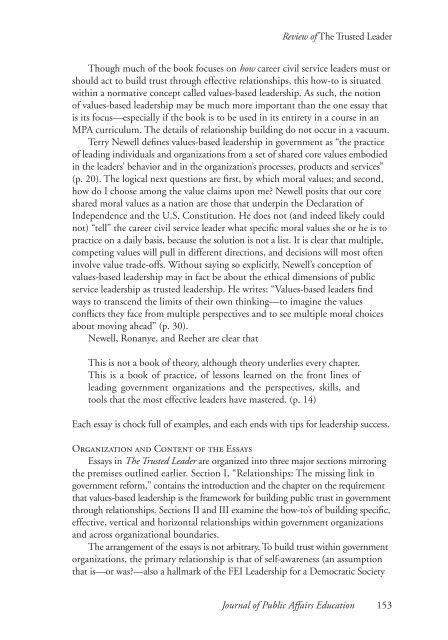Journal of Public Affairs Education
Create successful ePaper yourself
Turn your PDF publications into a flip-book with our unique Google optimized e-Paper software.
Review <strong>of</strong> The Trusted Leader<br />
Though much <strong>of</strong> the book focuses on how career civil service leaders must or<br />
should act to build trust through effective relationships, this how-to is situated<br />
within a normative concept called values-based leadership. As such, the notion<br />
<strong>of</strong> values-based leadership may be much more important than the one essay that<br />
is its focus—especially if the book is to be used in its entirety in a course in an<br />
MPA curriculum. The details <strong>of</strong> relationship building do not occur in a vacuum.<br />
Terry Newell defines values-based leadership in government as “the practice<br />
<strong>of</strong> leading individuals and organizations from a set <strong>of</strong> shared core values embodied<br />
in the leaders’ behavior and in the organization’s processes, products and services”<br />
(p. 20). The logical next questions are first, by which moral values; and second,<br />
how do I choose among the value claims upon me? Newell posits that our core<br />
shared moral values as a nation are those that underpin the Declaration <strong>of</strong><br />
Independence and the U.S. Constitution. He does not (and indeed likely could<br />
not) “tell” the career civil service leader what specific moral values she or he is to<br />
practice on a daily basis, because the solution is not a list. It is clear that multiple,<br />
competing values will pull in different directions, and decisions will most <strong>of</strong>ten<br />
involve value trade-<strong>of</strong>fs. Without saying so explicitly, Newell’s conception <strong>of</strong><br />
values-based leadership may in fact be about the ethical dimensions <strong>of</strong> public<br />
service leadership as trusted leadership. He writes: “Values-based leaders find<br />
ways to transcend the limits <strong>of</strong> their own thinking—to imagine the values<br />
conflicts they face from multiple perspectives and to see multiple moral choices<br />
about moving ahead” (p. 30).<br />
Newell, Ronanye, and Reeher are clear that<br />
This is not a book <strong>of</strong> theory, although theory underlies every chapter.<br />
This is a book <strong>of</strong> practice, <strong>of</strong> lessons learned on the front lines <strong>of</strong><br />
leading government organizations and the perspectives, skills, and<br />
tools that the most effective leaders have mastered. (p. 14)<br />
Each essay is chock full <strong>of</strong> examples, and each ends with tips for leadership success.<br />
Organization and Content <strong>of</strong> the Essays<br />
Essays in The Trusted Leader are organized into three major sections mirroring<br />
the premises outlined earlier. Section I, “Relationships: The missing link in<br />
government reform,” contains the introduction and the chapter on the requirement<br />
that values-based leadership is the framework for building public trust in government<br />
through relationships. Sections II and III examine the how-to’s <strong>of</strong> building specific,<br />
effective, vertical and horizontal relationships within government organizations<br />
and across organizational boundaries.<br />
The arrangement <strong>of</strong> the essays is not arbitrary. To build trust within government<br />
organizations, the primary relationship is that <strong>of</strong> self-awareness (an assumption<br />
that is—or was?—also a hallmark <strong>of</strong> the FEI Leadership for a Democratic Society<br />
<strong>Journal</strong> <strong>of</strong> <strong>Public</strong> <strong>Affairs</strong> <strong>Education</strong> 153



